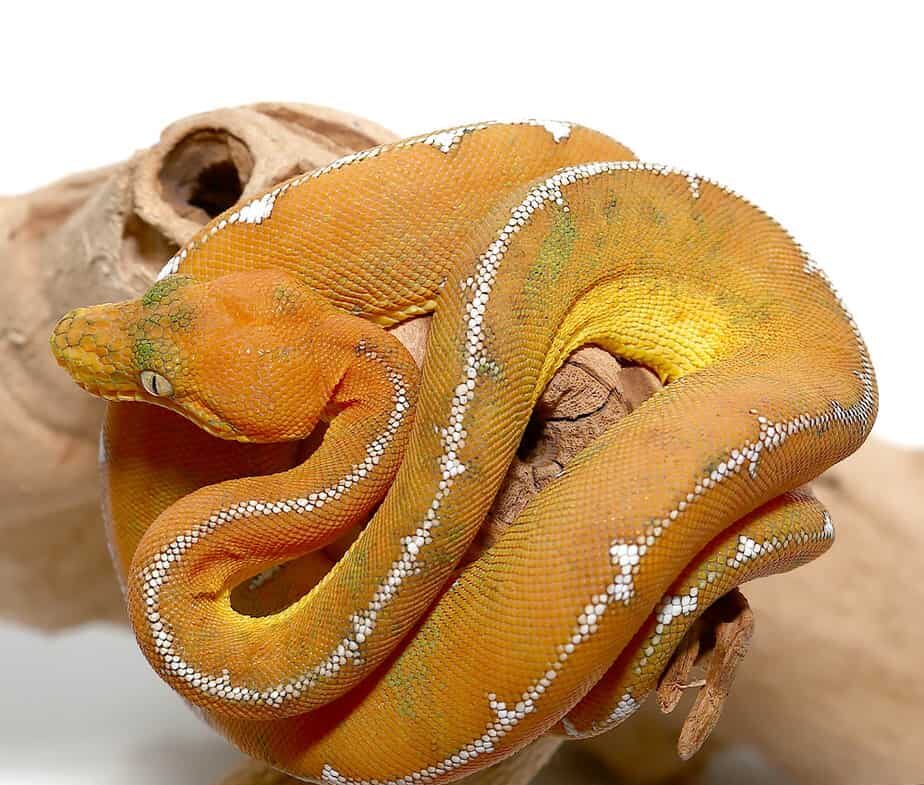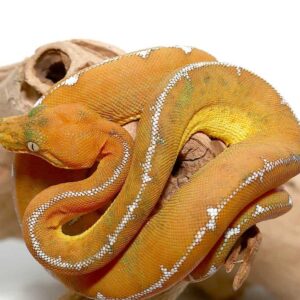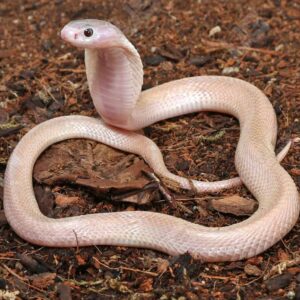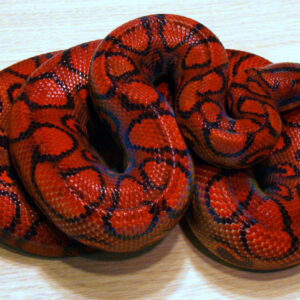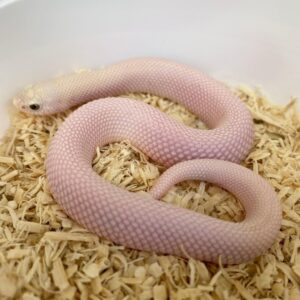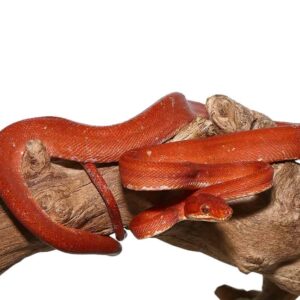Baby Amazon Basin Emerald Tree Boa For Sale
$3,999.99
WE HAVE BABY AMAZON BASIN EMERALD TREE BOA FOR SALE. HERE ARE SOME HIGHLIGHTS:
- Corallus batesii
- Captive Bred
- Approximately 20 Inches In Length
- Rare Species Of Emerald Tree Boa Known For Having Lots Of Bright White Patterning
- These Get Much Larger Than Normal Emeralds And They’re Highly Sought Out For
- Feeding On Live Fuzzy Mice
- Originating From South America From Southern Parts Of Brazil, Colombia And Venezuela Along The Amazon River
- With Proper Care These Boas Can Live Up To 20 – 30 Years
- Full Grown Adults Can Get As Long As 7 – 9 Feet In Length From Head To Tail
- Highly Desirable Due To Their Large Size For A Tree Boa And Extreme White Patterning
- This Fantastic Snake Has The Largest Teeth Out Of Any Non-venomous Snake Species, That Is Prefect For Piercing Through Feathers
Description
The Amazon Basin Emerald Tree Boa, scientifically known as Corallus batesii, is a remarkable species renowned for its striking appearance and fascinating behavior. This non-venomous snake, indigenous to the lush Amazon rainforest, boasts a vibrant green coloration adorned with white, irregularly shaped crossbands, making it a standout amongst the diverse fauna of its habitat. These aesthetic features are not merely for show; they provide excellent camouflage amidst the dense foliage and branches where it resides.
The Amazon Basin Emerald Tree Boa is an arboreal species, meaning it spends the majority of its life in trees. This arboreal nature is complemented by its prehensile tail, which enhances its ability to maneuver and secure itself among the branches. Typically, these boas can reach lengths of six to nine feet, with females often being larger than males. Their diet primarily consists of small mammals, birds, and occasionally lizards, which they capture using their keen sense of heat detection.
The ecological significance of the Amazon Basin Emerald Tree Boa is profound. As both predator and prey, it plays a crucial role in maintaining the balance within its ecosystem. It aids in controlling the populations of its prey species while also serving as a food source for larger predators. This intricate web of interactions highlights the importance of preserving its natural habitat, which is increasingly threatened by deforestation and human encroachment.
Herpetologists and reptile enthusiasts are particularly captivated by the Amazon Basin Emerald Tree Boa due to its unique characteristics and the challenges it presents in terms of care and study. Its nocturnal and elusive nature makes it a subject of intrigue and admiration. Furthermore, its relatively docile temperament and stunning appearance make it a sought-after species among reptile collectors, although it requires a high level of expertise to maintain in captivity.
In summary, the Amazon Basin Emerald Tree Boa is a species that not only enhances the biodiversity of the Amazon rainforest but also serves as a symbol of the intricate beauty and complexity of tropical ecosystems. Its continued study and conservation are essential for both scientific understanding and ecological preservation.
Habitat and Distribution
The Amazon Basin Emerald Tree Boa, scientifically known as Corallus batesii, inhabits the lush, dense rainforests of the Amazon Basin, a vast region that spans multiple South American countries including Brazil, Peru, Ecuador, Colombia, and Bolivia. This region is characterized by its incredible biodiversity and complex ecosystems, making it an ideal habitat for this strikingly beautiful species.
Primarily arboreal, the Amazon Basin Emerald Tree Boa thrives in the canopy layers of these rainforests. The dense vegetation provides ample cover and hunting opportunities, as the boa is an ambush predator, relying on its vibrant green coloration to blend seamlessly with the foliage. This camouflage is crucial for its survival, aiding in both predation and avoiding potential threats.
Environmental conditions in the Amazon Basin play a significant role in shaping the behavior and lifestyle of the Emerald Tree Boa. The region is known for its high humidity levels, often exceeding 80%, and consistently warm temperatures that range between 75°F to 85°F (24°C to 29°C). These conditions are essential for the boa’s thermoregulation and overall metabolic processes.
Moreover, the Amazon Basin experiences a substantial amount of rainfall annually, creating a moist environment that supports the boa’s need for hydration. The abundant water sources, from rivers and streams to the frequent rain showers, ensure that the habitat remains conducive to the boa’s survival. Additionally, the thick canopy cover helps maintain the humidity and temperature levels required by the species.
In essence, the Amazon Basin’s unique environmental conditions, including its consistent warmth, high humidity, and dense vegetation, are integral to the well-being and behavioral patterns of the Amazon Basin Emerald Tree Boa. Understanding these habitat requirements is crucial for conservation efforts and ensuring that this enigmatic species continues to thrive in its natural environment.
Physical Characteristics
The Amazon Basin Emerald Tree Boa is renowned for its striking appearance, primarily characterized by its vivid emerald green coloration. This vivid hue is interspersed with irregular white or yellow crossbands, creating a distinctive and visually captivating pattern. The scales of the Amazon Basin Emerald Tree Boa are smooth and glossy, enhancing its vibrant color and making it a standout among other reptiles.
One of the most fascinating aspects of this species is its remarkable ability to blend seamlessly into its environment. The emerald green color provides excellent camouflage among the foliage of its rainforest habitat, an adaptation crucial for both predation and evasion of predators. This effective camouflage allows the Amazon Basin Emerald Tree Boa to remain undetected by both its prey and potential threats.
When compared to its close relative, the Northern Emerald Tree Boa (Corallus caninus), subtle differences become apparent. While both species share a similar green coloration, the Amazon Basin variant typically exhibits a more uniform green with fewer interruptions in its pattern. In contrast, the Northern Emerald Tree Boa may have more pronounced and numerous white markings, which can vary significantly among individuals. Moreover, the Amazon Basin Emerald Tree Boa is generally larger, often exceeding lengths of six feet, whereas the Northern Emerald Tree Boa typically measures slightly shorter.
The physical adaptations of the Amazon Basin Emerald Tree Boa play a vital role in its survival. Its prehensile tail aids in maneuvering through the dense rainforest canopy, allowing it to grasp branches securely. Additionally, its heat-sensing pits, located along the upper lip, enable it to detect warm-blooded prey even in the dark, further enhancing its hunting efficiency.
In summary, the Amazon Basin Emerald Tree Boa’s physical characteristics not only make it a visually stunning species but also contribute significantly to its success as a predator in the complex ecosystem of the Amazon Basin. The combination of its striking green coloration, unique scale patterns, and specialized adaptations underscores the remarkable evolutionary path this species has taken.
Behavior and Diet
The Amazon Basin Emerald Tree Boa exhibits a fascinating array of behaviors, primarily characterized by its nocturnal and arboreal lifestyle. As a nocturnal species, this snake is most active during the night, taking advantage of the cover of darkness to hunt. During the day, it often remains motionless, coiled around trees and blending seamlessly with the foliage to avoid predators and conserve energy.
Arboreal by nature, the Amazon Basin Emerald Tree Boa spends the majority of its life in the trees, utilizing its strong prehensile tail to navigate the complex canopy. This adaptation not only aids in mobility but also plays a crucial role in its hunting strategy. The snake employs a sit-and-wait approach, positioning itself on branches where it can strike unsuspecting prey. This method is highly efficient, allowing the boa to capture a diverse range of prey.
The diet of the Amazon Basin Emerald Tree Boa primarily consists of birds, small mammals, and occasionally reptiles. Its predation technique involves ambushing prey with a swift strike, followed by constriction. This method is effective against a variety of prey, from small rodents scurrying along branches to birds perching in the canopy. The boa’s heat-sensitive pits enable it to detect warm-blooded prey even in complete darkness, enhancing its hunting efficiency.
Feeding frequency for the Amazon Basin Emerald Tree Boa is relatively low, as it can go several weeks between meals. This is partly due to its slow metabolism, a common trait among many snake species. After consuming a meal, the snake will often remain inactive for extended periods, focusing its energy on digestion. This prolonged digestion time is particularly important for large prey, which can sustain the boa for a significant duration.
Special dietary adaptations of the Amazon Basin Emerald Tree Boa include its ability to consume relatively large prey compared to its body size. This capability is facilitated by its flexible jaws and expandable stomach, allowing it to tackle a wide range of prey sizes. Such adaptations are essential for survival in the diverse and often unpredictable environment of the Amazon Basin.
Reproduction and Lifespan
The Amazon Basin Emerald Tree Boa, a captivating species known for its vibrant green coloration and intricate patterning, exhibits fascinating reproductive habits. The breeding season for this species generally occurs during the wet season, which spans from November to March. During this period, males actively seek out females by following scent trails, an essential part of their mating ritual. Courtship involves the male wrapping around the female and engaging in a series of rhythmic contractions and nudges to stimulate acceptance for copulation.
Once mating has occurred, the gestation period for the Amazon Basin Emerald Tree Boa lasts approximately six to seven months. Unlike many reptiles that lay eggs, this species is ovoviviparous, meaning the females give birth to live young. Typically, a female may produce a litter ranging from six to twenty offspring, though the number can vary based on factors such as the female’s age and overall health.
The newborn boas are highly independent from birth and are equipped with sharp teeth and vibrant coloration. However, despite their readiness, survival rates in the wild can be challenging due to predation and environmental factors. In captivity, where threats are minimized, these young boas have a higher likelihood of reaching maturity.
In terms of lifespan, the Amazon Basin Emerald Tree Boa displays notable longevity. In their natural habitat, they usually live up to 15 years, adapting to the dynamic and often harsh conditions of the Amazon Basin. In contrast, individuals kept in captivity, with controlled environments and regular feeding, can extend their lifespan to over 20 years. This significant difference highlights the impact of environmental stability and care on the health and longevity of this remarkable species.
Conservation Status
The Amazon Basin Emerald Tree Boa (Corallus batesii) faces various challenges that threaten its survival in the wild. One of the most pressing issues is habitat destruction. The Amazon rainforest, home to this striking snake, is being rapidly deforested for agriculture, logging, and infrastructure development. This loss of habitat not only reduces the available territory for the tree boa but also disrupts the intricate ecosystem it relies on for food and shelter.
Climate change further exacerbates the situation. Alterations in temperature and precipitation patterns can affect the availability of prey and suitable living conditions for the Amazon Basin Emerald Tree Boa. These environmental changes may force the species to migrate to less ideal habitats, increasing their vulnerability to predators and reducing their chances of survival.
The pet trade poses another significant threat to the Amazon Basin Emerald Tree Boa. Due to its vivid green coloration and striking appearance, this species is highly sought after by reptile enthusiasts. Although international trade regulations, such as the Convention on International Trade in Endangered Species of Wild Fauna and Flora (CITES), aim to control the export and import of this species, illegal trading continues to be a problem. Overharvesting for the pet trade can lead to population declines, further endangering the species.
Conservation efforts have been initiated to protect the Amazon Basin Emerald Tree Boa and its habitat. Organizations and governmental bodies are working to establish protected areas within the Amazon rainforest, ensuring that large sections of this crucial ecosystem remain intact. Additionally, educational campaigns are being conducted to raise awareness about the importance of preserving this species and the threats it faces. Legal protections, including stricter enforcement of existing wildlife trade laws, are also crucial in curbing illegal activities that endanger the boa.
In summary, the conservation status of the Amazon Basin Emerald Tree Boa is precarious, with habitat destruction, climate change, and the pet trade posing significant threats. However, ongoing conservation initiatives and legal protections offer hope for the preservation of this remarkable species and its natural habitat.
Captive Care and Husbandry
The Amazon Basin Emerald Tree Boa (Corallus batesii) is a captivating species prized for its vibrant coloration and arboreal nature. Proper care and husbandry are crucial to ensuring the health and well-being of these snakes in captivity. To begin with, the enclosure size should be sufficient to allow the boa to exhibit natural behaviors. A vertically oriented enclosure measuring at least 3 feet in height, 2 feet in width, and 2 feet in depth is recommended for adults, equipped with sturdy branches and perches to mimic their natural habitat.
Maintaining appropriate temperature and humidity levels is essential. The ambient temperature should range between 75-85°F, with a basking spot that reaches up to 90°F. At night, temperatures can drop to around 70-75°F. Humidity should be kept between 70-80%, replicating the moist environment of the Amazon Basin. Regular misting and the use of a hygrometer can help achieve and monitor these conditions.
Diet plays a vital role in the health of the Amazon Basin Emerald Tree Boa. In captivity, their diet primarily consists of appropriately sized rodents. Juveniles should be fed every 7-10 days, while adults can be fed every 10-14 days. It is important to ensure that prey items are not too large, as this can lead to regurgitation and other health issues.
Handling should be done with care to avoid undue stress. These boas can be defensive and may strike if they feel threatened. Using a snake hook can assist in safely moving the boa, and handling sessions should be kept brief and infrequent to minimize stress.
Regular health care is imperative. Owners should watch for signs of common issues such as respiratory infections, mites, and incomplete sheds. A qualified reptile veterinarian can provide guidance and treatment if any health problems arise.
By adhering to these care guidelines, enthusiasts can ensure a healthy and enriching environment for their Amazon Basin Emerald Tree Boa, allowing them to thrive in captivity.
Cultural and Scientific Significance
The Amazon Basin Emerald Tree Boa holds a unique position in the cultural and scientific tapestry of the regions it inhabits. Indigenous cultures of the Amazon have long revered this striking serpent, often symbolizing it in their folklore and mythology. The snake’s vibrant green coloration and arboreal lifestyle have inspired numerous tales that emphasize its mystical presence within the rainforest. For many indigenous communities, the Emerald Tree Boa is not merely an animal but a guardian of the forest, embodying the vitality and complexity of their natural surroundings.
From a scientific standpoint, the Amazon Basin Emerald Tree Boa is equally significant. Herpetologists have extensively studied this species to understand its unique adaptations to an arboreal lifestyle. The snake’s prehensile tail, exceptional camouflage, and thermoregulatory behaviors provide valuable insights into the evolutionary processes that enable survival in dense rainforest canopies. These studies have broader implications for ecological research, contributing to our understanding of biodiversity and ecosystem dynamics in the Amazon Basin.
The Emerald Tree Boa also plays a crucial role in the field of ecology. As both predator and prey, it is integral to the food web, influencing the population dynamics of its prey species such as small mammals and birds. This balance is essential for maintaining the health of the rainforest ecosystem. Research on the Emerald Tree Boa’s interactions within its habitat helps ecologists develop conservation strategies, particularly in the face of deforestation and climate change.
The allure of the Amazon Basin Emerald Tree Boa extends beyond scientific circles. Its mesmerizing appearance and enigmatic nature have captured the imagination of the public, leading to notable appearances in media and literature. Documentaries, books, and even artwork often feature this snake, highlighting its role as an ambassador of the Amazon’s rich biodiversity. Through these mediums, the Emerald Tree Boa continues to educate and inspire, fostering a deeper appreciation for the natural world.

